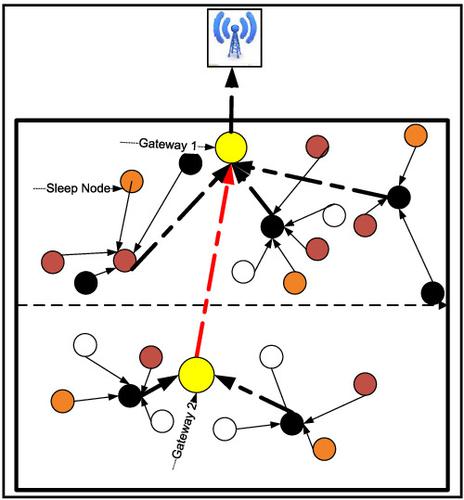当前位置:
X-MOL 学术
›
Int. J. Commun. Syst.
›
论文详情
Our official English website, www.x-mol.net, welcomes your feedback! (Note: you will need to create a separate account there.)
A novel dynamic clustering approach for energy hole mitigation in Internet of Things‐based wireless sensor network
International Journal of Communication Systems ( IF 2.1 ) Pub Date : 2021-04-10 , DOI: 10.1002/dac.4806 Roopali Dogra 1 , Shalli Rani 1 , Bhisham Sharma 2 , Sandeep Verma 3 , Divya Anand 4 , Pushpita Chatterjee 5
International Journal of Communication Systems ( IF 2.1 ) Pub Date : 2021-04-10 , DOI: 10.1002/dac.4806 Roopali Dogra 1 , Shalli Rani 1 , Bhisham Sharma 2 , Sandeep Verma 3 , Divya Anand 4 , Pushpita Chatterjee 5
Affiliation

|
With the advancements in the technology, Internet of Things (IoT)‐based wireless sensor networks (WSNs) have shown a tremendous growth in rendering a huge number of applications across the globe. However, it is observed that IoT‐based sensor nodes suffer from energy limitations. To resolve this, cluster‐based topology is adapted by the various researchers for rendering green energy‐efficient solution for communication of IoT devices. In this paper, the dynamic and energy‐efficient clustering for energy hole mitigation (DECEM) is proposed. The proposed framework is composed of the following proposed attributes; network is divided in two halves of regions, in each half, a gateway node (GN) is selected that collects data from their corresponding half region. Further, in each cluster, two cluster heads (CHs) are selected among whom one is made active at a moment (remains active until 60% of its energy is consumed) and other stays in sleep mode. First, the GN is selected in each side of the network (divided into two halves), and later, clustering is done, and selection of two CHs in each cluster is performed. The parameters for the selection of GN and CHs include residual energy, separation between the node and the sink, the number of neighbour nodes and network's residual energy. The simulation experiments reveal that DECEM has enhanced stability period by 5% and 31% as compared to the MEEC and IDHR protocols, respectively. The network lifetime is gigantically improved by 56% as compared to MEEC protocol.
中文翻译:

一种基于物联网的无线传感器网络中减少能量漏洞的新型动态聚类方法
随着技术的进步,基于物联网(IoT)的无线传感器网络(WSN)在呈现全球范围内大量应用程序方面已显示出巨大的增长。但是,据观察,基于IoT的传感器节点受到能量限制。为了解决这个问题,各种研究人员对基于集群的拓扑进行了修改,以提供绿色节能解决方案,用于IoT设备的通信。在本文中,提出了动态和节能聚类的能量空穴缓解(DECEM)。提议的框架由以下提议的属性组成;将网络分为两半区域,在每一半中,选择一个网关节点(GN),该网关节点从其相应的半区域中收集数据。此外,在每个群集中 选择两个簇头(CH),其中一个簇头立即处于活动状态(直到消耗掉其60%的能量时才处于活动状态),而另一个簇处于睡眠模式。首先,在网络的每一侧(分为两半)选择GN,然后进行聚类,并在每个聚类中执行两个CH的选择。用于选择GN和CH的参数包括剩余能量,节点与宿之间的距离,相邻节点的数量以及网络的剩余能量。仿真实验表明,与MEEC和IDHR协议相比,DECEM的稳定期分别提高了5%和31%。与MEEC协议相比,网络寿命大大提高了56%。在网络的每一侧(分为两半)选择GN,然后进行聚类,并在每个聚类中执行两个CH的选择。用于选择GN和CH的参数包括剩余能量,节点与宿之间的距离,相邻节点的数量以及网络的剩余能量。仿真实验表明,与MEEC和IDHR协议相比,DECEM的稳定期分别提高了5%和31%。与MEEC协议相比,网络寿命大大提高了56%。在网络的每一侧(分为两半)选择GN,然后进行聚类,并在每个聚类中执行两个CH的选择。用于选择GN和CH的参数包括剩余能量,节点与宿之间的距离,相邻节点的数量以及网络的剩余能量。仿真实验表明,与MEEC和IDHR协议相比,DECEM的稳定期分别提高了5%和31%。与MEEC协议相比,网络寿命大大提高了56%。邻居节点的数量和网络的剩余能量。仿真实验表明,与MEEC和IDHR协议相比,DECEM的稳定期分别提高了5%和31%。与MEEC协议相比,网络寿命大大提高了56%。邻居节点的数量和网络的剩余能量。仿真实验表明,与MEEC和IDHR协议相比,DECEM的稳定期分别提高了5%和31%。与MEEC协议相比,网络寿命大大提高了56%。
更新日期:2021-05-04
中文翻译:

一种基于物联网的无线传感器网络中减少能量漏洞的新型动态聚类方法
随着技术的进步,基于物联网(IoT)的无线传感器网络(WSN)在呈现全球范围内大量应用程序方面已显示出巨大的增长。但是,据观察,基于IoT的传感器节点受到能量限制。为了解决这个问题,各种研究人员对基于集群的拓扑进行了修改,以提供绿色节能解决方案,用于IoT设备的通信。在本文中,提出了动态和节能聚类的能量空穴缓解(DECEM)。提议的框架由以下提议的属性组成;将网络分为两半区域,在每一半中,选择一个网关节点(GN),该网关节点从其相应的半区域中收集数据。此外,在每个群集中 选择两个簇头(CH),其中一个簇头立即处于活动状态(直到消耗掉其60%的能量时才处于活动状态),而另一个簇处于睡眠模式。首先,在网络的每一侧(分为两半)选择GN,然后进行聚类,并在每个聚类中执行两个CH的选择。用于选择GN和CH的参数包括剩余能量,节点与宿之间的距离,相邻节点的数量以及网络的剩余能量。仿真实验表明,与MEEC和IDHR协议相比,DECEM的稳定期分别提高了5%和31%。与MEEC协议相比,网络寿命大大提高了56%。在网络的每一侧(分为两半)选择GN,然后进行聚类,并在每个聚类中执行两个CH的选择。用于选择GN和CH的参数包括剩余能量,节点与宿之间的距离,相邻节点的数量以及网络的剩余能量。仿真实验表明,与MEEC和IDHR协议相比,DECEM的稳定期分别提高了5%和31%。与MEEC协议相比,网络寿命大大提高了56%。在网络的每一侧(分为两半)选择GN,然后进行聚类,并在每个聚类中执行两个CH的选择。用于选择GN和CH的参数包括剩余能量,节点与宿之间的距离,相邻节点的数量以及网络的剩余能量。仿真实验表明,与MEEC和IDHR协议相比,DECEM的稳定期分别提高了5%和31%。与MEEC协议相比,网络寿命大大提高了56%。邻居节点的数量和网络的剩余能量。仿真实验表明,与MEEC和IDHR协议相比,DECEM的稳定期分别提高了5%和31%。与MEEC协议相比,网络寿命大大提高了56%。邻居节点的数量和网络的剩余能量。仿真实验表明,与MEEC和IDHR协议相比,DECEM的稳定期分别提高了5%和31%。与MEEC协议相比,网络寿命大大提高了56%。


























 京公网安备 11010802027423号
京公网安备 11010802027423号